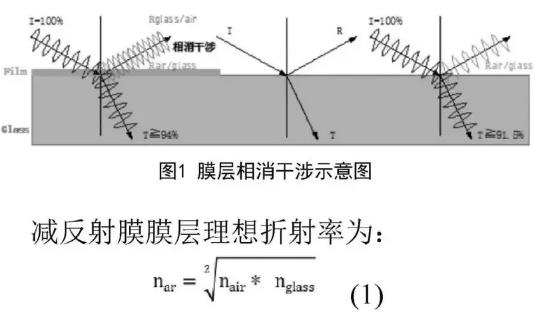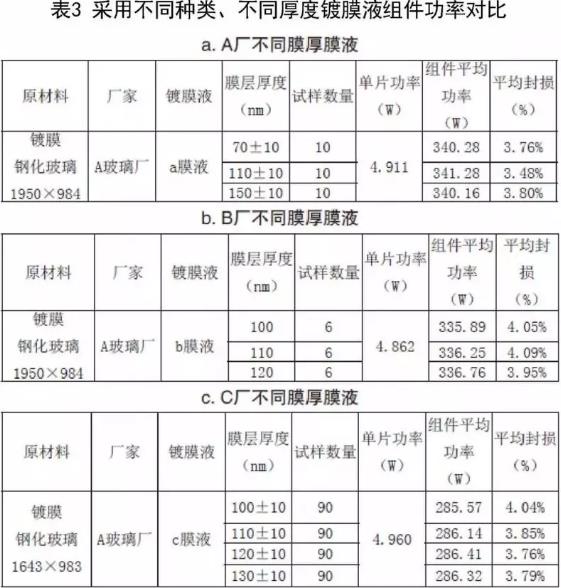As the "leader" plan advances to put forward higher and higher requirements for the conversion efficiency of photovoltaic modules, the upgrade of module technology continuously reduces the optical loss and electrical loss of packaging from the aspects of solar cells, packaging processes, packaging materials, etc. Among them, the light transmission effect of photovoltaic glass is one of the important factors that affect the power generation capacity of photovoltaic modules. Adding anti-reflection film on the surface of photovoltaic glass can effectively improve the power of the module. However, due to the diversity of choices of anti-reflection film, there are generally PV modules using the same technical indicators in the production process of the module, but the components with large power differences are produced. Investigate the reason, in addition to the need to consider the matching between batteries, packaging technology and other packaging materials, the characteristics of photovoltaic glass and its matching with the optical characteristics of the battery are also particularly important.
This paper studies and analyzes the optical properties of photovoltaic coated glass and the matching of photovoltaic glass and solar cells. By comparing the effect of different coated photovoltaic glass on module power, as well as the analysis of glass optical performance and QE data of multi-position solar cells, to determine PV glass characteristic index better matched with solar cells. And through modeling and calculation to determine the optimal coating parameters of photovoltaic glass, and a series of tests to verify that the optimized coating of photovoltaic glass can further increase the power of the module.
1. Application of coated photovoltaic glass
1.1 Coated photovoltaic glass
One of the main reasons for the power loss of photovoltaic modules is the reflection loss of photovoltaic glass close to 10% of the sunlight. If a layer of antireflection coating is plated on the glass surface, the scattering rate of the glass surface will be reduced to effectively improve the conversion efficiency of the photovoltaic module. Coated photovoltaic glass is photovoltaic nano anti-reflection film photovoltaic glass, which is to add a nano-SiO2 anti-reflection film coating on the surface of ordinary photovoltaic glass, and then undergo a heat treatment process to make the film layer and the glass substrate firmly combined. AR coatings use the principle of light interference on the surface of the film to interfere with each other to minimize reflected light. They can be divided into single-layer AR coatings, double-layer AR coatings and multilayer AR coatings. However, due to factors such as manufacturing cost and reliability, only single-layer coated photovoltaic glass is still widely used. Coated glass has a higher transmittance to light, the transmittance of ordinary ultra-white embossed tempered glass can reach more than 91.7%, and the transmittance of coated glass can reach 94%, so it can increase the output power of the module by about 1.5 ~ 2% .
1.2 Principle of power gain
According to the principle of thin film interference, a thin film with a refractive index less than glass and greater than air can be coated with a thin film on the surface of the glass to achieve better anti-reflection effects, as shown in Figure 1.

When the refractive index of air nair = 1, the refractive index of glass nglass = 1.48 ~ 1.56, for the soda-lime silicate glass for photovoltaics, it is generally nglass = 1.52, so the ideal refractive index of anti-reflection coating nar≈1.23. The thickness dAr of the antireflection film is basically about 1/4 of the average wavelength of visible light, that is, dAR = λ / (4 * nair), and a better film thickness can be obtained, and at this time, the device can also obtain higher optical input. If the peak value of the transmission curve of photovoltaic glass λ = 550 ~ 650nm, then the corresponding film thickness dAr≈110 ~ 130nm. However, in actual production, because the refractive index of the photovoltaic glass film is different and the spectral characteristics of the solar cell are also different, it is still necessary to test and verify the thickness of the glass film that the component can obtain the best power gain.
2. Matching analysis
The spectral response range of crystalline silicon solar cells is 300 ~ 1200nm, and light in this wavelength range will produce a photovoltaic effect to achieve the conversion of light energy to electrical energy. However, when light passes through various layers of packaging materials, due to changes in the interface, the light reflection will change, and the packaging material itself will absorb the incident light to varying degrees, so it will cause a certain optical loss, so the transmittance of the packaging material is The optical loss of components has a significant effect.
2.1 Analysis of solar cell QE data and transmittance of coated photovoltaic glass
The efficiency of the solar cell for the visible light part of the long wavelength band is high, and the efficiency of the short-wave ultraviolet part is poor. To improve the light transmission effect of the photovoltaic glass and make it more compatible with the performance of the solar cell, it can be further improved. The absorption effect of the solar cell on the full-band sunlight, thereby improving the conversion efficiency of the photovoltaic module. By analyzing the QE curve of the single crystal battery with a conversion efficiency of 19.9% ​​to 20.3%, it can be seen that the trend of change is the same, and the peaks of QE appear in the 550-650nm band. The light transmittance test of photovoltaic glass with different coating thickness shows that when the coating thickness is 110 ~ 120nm, the light transmittance in the wavelength range of 550 ~ 650nm can reach the peak.


Through the simulation calculation of the transmittance of the coated photovoltaic glass, the optimal coating thickness of the photovoltaic glass should also be controlled between 110-130nm, but considering that there are certain differences in the matching of different types of coating solutions and batteries, so further tests are needed to verify the photovoltaic glass coating The relationship between thickness and component power gain.
3. Test verification
3.1 Component power verification of different coated photovoltaic glass
Comparing photovoltaic glass with different coating solutions, there is no significant difference in the component power when the thickness of the photovoltaic glass coating is limited. The comparative samples in this article use the same batch of materials and are compared under the same equipment and operating conditions.

3.2 Verification of photovoltaic glass with different coating thickness

According to the data in Table 1, it can be preliminarily judged that the module power has a significant gain when the thickness of the photovoltaic glass coating is about 110 nm. Therefore, the range of optimized film thickness is limited to 110nm, and the increase and decrease of 10nm interval, and then the comparison of different photovoltaic glass manufacturers with different film thickness photovoltaic glass module power. It is confirmed by the batch sample data in Table 3b and c: When the thickness of the photovoltaic glass film is 120nm as the reference value, the power gain of the photovoltaic module is the largest, which is the same as the current photovoltaic glass technical indicators that only require light transmittance and no limit on the film thickness. Compared with the module, the module power has a gain.
4 Conclusion
At present, there are diversified choices of photovoltaic glass coating liquid types and manufacturers. Due to the differences in the technical indicators of coated tempered glass, the problems of actual power dissipation of component power levels and the failure of component conversion efficiency to reach expected targets are caused. Through the above theoretical analysis and series of experiments, it is verified that when the thickness of the photovoltaic glass layer is based on the range of 110 ~ 120nm and controlled to the smallest possible accuracy, the power of the module will gain.
Stainless Steel Hex Head Flange Bolt, are Made from 304 316 stainless steel, these screws have good chemical resistance and may be mildly magnetic. The flange distributes pressure where the screw meets the surface, eliminating the need for a separate washer. Head height includes the flange. Length is measured from under the flange.
Hexagon flange bolts, also known as hex flange bolts or flanged bolts, are a type of fastener that feature a hexagonal head with a built-in washer or flange. The flange provides a larger bearing surface, which helps distribute the load and prevent the bolt from sinking into the material being fastened.
These bolts are commonly used in applications where a strong and secure fastening is required, such as automotive, construction, and industrial machinery. The flange also acts as a built-in washer, eliminating the need for a separate washer during installation.
Hexagon flange bolts are typically made from steel or stainless steel and are available in various sizes and grades to meet specific application requirements. They are installed using a wrench or socket, which fits the hexagonal head.
Hexagon Flange Bolts,Hexagon Flange Screw,Flanged Hexagon Bolts,Hexagonal Flange Bolt
Taizhou Wanluo Hardware Products Co., Ltd. , https://www.wlhardware.com
![<?echo $_SERVER['SERVER_NAME'];?>](/template/twentyseventeen/skin/images/header.jpg)